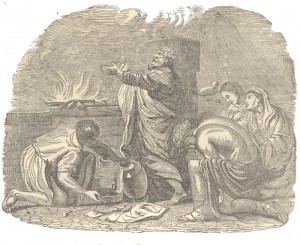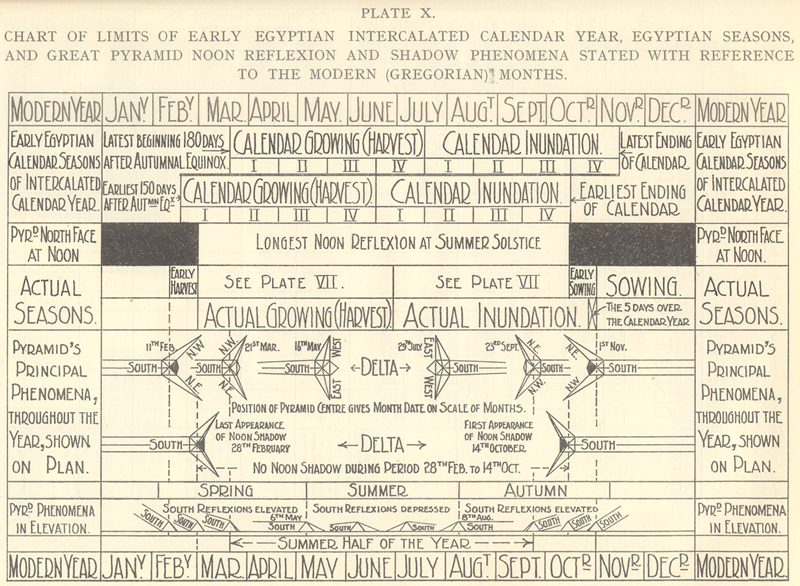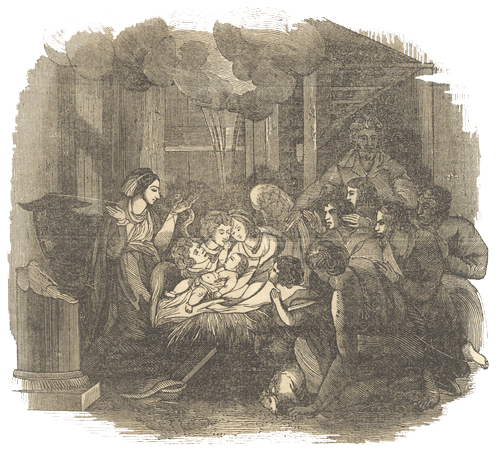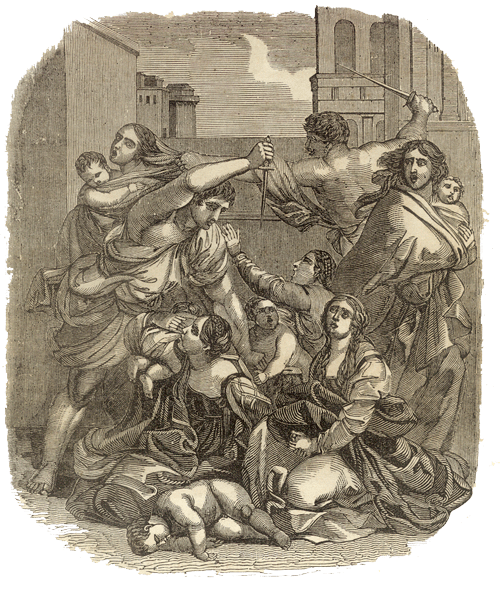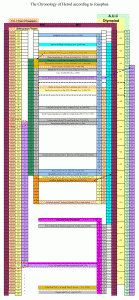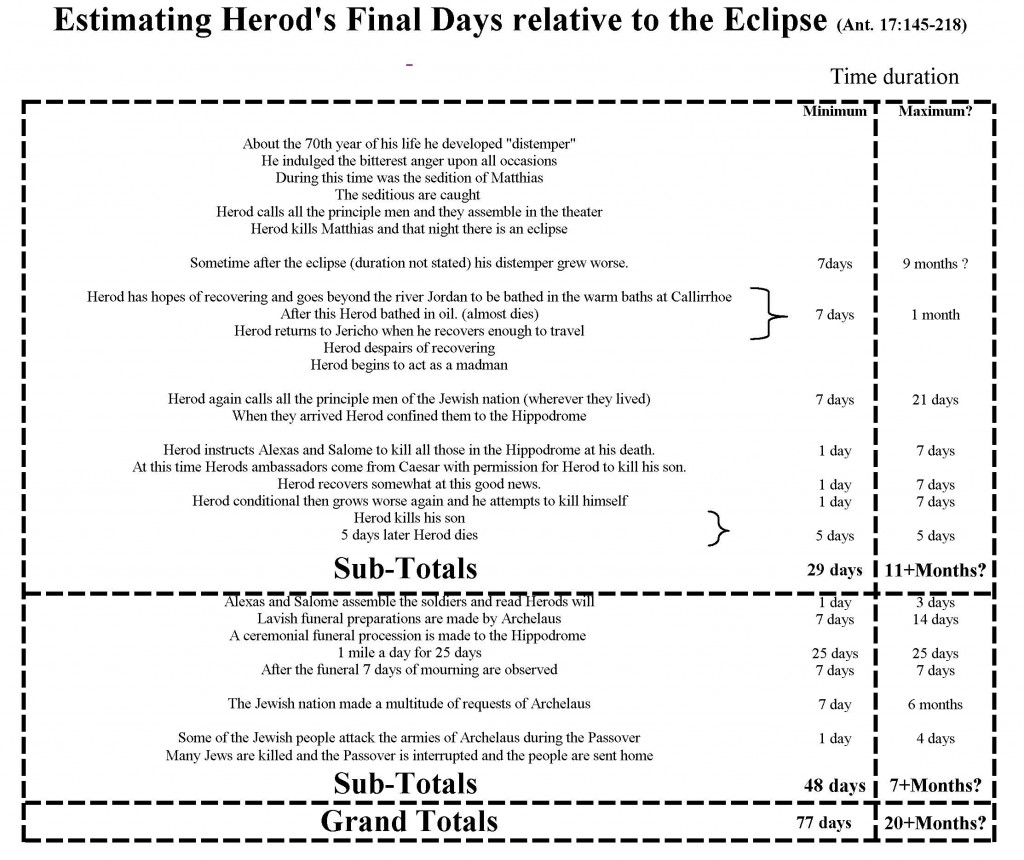In my last blog post, Halloween and the Bible, we looked at the fascinating history of Halloween and the flood of Noah. Today I want to share with you how those events are related to Israel’s exodus from Egypt, the Biblical calendar, and the promise of the coming Messiah. David Jesse, a blogger I read, has a saying which I really love. He says “Context makes the Bible come alive”. Today I want to share with you some unique historical facts about Egypt and Israel’s exodus in the hope that this information will make the Bible come alive for you in a new way.
The Descendants of Seth
First let’s travel back to the time of Christ and a Jewish historian named Josephus. Nearly two thousand years ago Josephus had this to say about the flood:
Now this Seth, when he was brought up, and came to those years in which he could discern what was good, became a virtuous man; and as he was himself of an excellent character, so did he leave children behind him who imitated his virtues…
They also were the inventors of that peculiar sort of wisdom which is concerned with the heavenly bodies, and their order. And that their inventions might not be lost before they were sufficiently known, upon Adam’s prediction that the world was to be destroyed at one time by the force of fire, and at another time by the violence and quantity of water, they made two pillars, {e} the one of brick, the other of stone:
they inscribed their discoveries on them both, that in case the pillar of brick should be destroyed by the flood, the pillar of stone might remain, and exhibit those discoveries to mankind; and also inform them that there was another pillar of brick erected by them. Now this remains in the land of Siriad [Egypt] to this day…. (Antiquities of the Jews 1:68-71)
Interestingly in Isaiah 19:19 such a pillar is mentioned in the land of Egypt in a future messianic context. Here take a look:
In that day shall there be an altar to YHWH in the midst of the land of Egypt, and a pillar at the border thereof to YHWH. And it shall be for a sign and for a witness unto YHWH of hosts in the land of Egypt: for they shall cry unto YHWH because of the oppressors, and he shall send them a saviour, and a great one, and he shall deliver them. (Isaiah 19:19-20)
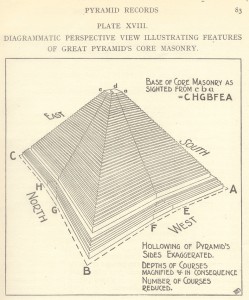 You see, nearly two thousand years ago the Great Pyramid in Egypt was already considered a monument built by the descendants of Seth to monumentalize a warning to mankind that judgement was coming. Some even claim this pillar has messianic significance. A discussion of whether this tradition is true or not will have to wait for another article, but we do know from the evidence of the Great Pyramid itself, that it was built in such a way that it marked the first day of November (and the Flood) in a very special way. I’ll get to that in a moment, but first let me describe this monument in a little more detail. For context’s sake keep in mind that Goshen, where the children of Israel lived for several hundred years, was only fifty miles or so from this great monument. In a moment you will see why the Great Pyramid was known to the ancient Egyptians as Ta Khut “The Light” and why it is still one of the greatest manmade wonders of the world.
You see, nearly two thousand years ago the Great Pyramid in Egypt was already considered a monument built by the descendants of Seth to monumentalize a warning to mankind that judgement was coming. Some even claim this pillar has messianic significance. A discussion of whether this tradition is true or not will have to wait for another article, but we do know from the evidence of the Great Pyramid itself, that it was built in such a way that it marked the first day of November (and the Flood) in a very special way. I’ll get to that in a moment, but first let me describe this monument in a little more detail. For context’s sake keep in mind that Goshen, where the children of Israel lived for several hundred years, was only fifty miles or so from this great monument. In a moment you will see why the Great Pyramid was known to the ancient Egyptians as Ta Khut “The Light” and why it is still one of the greatest manmade wonders of the world.
Now let me paint you a picture of the Great Pyramid as it was during the time of Israel’s sojourning in Egypt. The base of the Great Pyramid was 365.24 cubits squared covering 13 acres. This stone structure was laid out in relation to the cardinal points of the compass with the precision of a modern observatory. Its base circumference was 36,524 inches and its height was 5813 inches or nearly 484 feet. Quite literally, it was a manmade mountain. For perspective, you could take the stone mass of the Great Pyramid and it would make a wall one foot thick and four feet high stretching from New York to San Francisco. Now that is big!
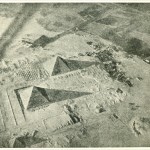 What really stood out about the Great Pyramid was its covering. The four slightly concave triangular sides of this incredible monument were covered with a casing of pure white polished limestone and fitted with such precision that even today engineers and archeologists have no conclusive idea how the task was accomplished. Oddly enough, the capstone or ‘head corner stone’, as it might be called in Biblical terms, was never placed on the Great Pyramid. In antiquity it was considered a stone rejected by its builders.
What really stood out about the Great Pyramid was its covering. The four slightly concave triangular sides of this incredible monument were covered with a casing of pure white polished limestone and fitted with such precision that even today engineers and archeologists have no conclusive idea how the task was accomplished. Oddly enough, the capstone or ‘head corner stone’, as it might be called in Biblical terms, was never placed on the Great Pyramid. In antiquity it was considered a stone rejected by its builders.
The Greek historian, Diodorus Siculus, observed that in his day (56-60 BC) the Great Pyramid was complete without any decay, but it lacked its capstone. (Diodorus Siculus, Book I, 63.4-64.14)
The Greek geographer Strabo who lived as a contemporary of Siculus is said to have stated that, “It seemed like a building let down from heaven without the aid of human hands.”
So we have a massive manmade structure with highly reflective sides fixed precisely to the cardinal points of the compass. This arrangement then produced reflective beams of lights and shadows marking the limits of the astronomical year with a brilliant display, hence the Egyptian title, “The Light”. Among its many characteristics the Great Pyramid was in fact an astronomical almanac. This purposeful design marked the 1st of November and the sowing season with a specific reflective effect which was used by the Egyptians to begin their agricultural cycle as well as their New Year. The chart below comes from Davidson’s Pyramid Records and it shows what the children of Israel likely saw during their captivity. In the far right of the chart note the reflective design which was seen on the 1st of November.
So okay, this is all a neat bit of history you might be thinking, but what does this have to do with Israel? Well, this is where it gets really amazing in my opinion. The Great Pyramid defined Egypt’s agricultural calendar and seasons with its reflective effect. This was the calendar system under which all Egypt operated during Israel’s captivity, one which reminded them of a great destruction of mankind.
After the exodus of Israel from Egypt one of the first things YHWH did was change Israel’s calendar from what they were familiar with in Egypt to a new calendar which began in the spring and commemorated the events of the Exodus.
And YHWH spake unto Moses and Aaron in the land of Egypt, saying, This month shall be unto you the beginning of months: it shall be the first month of the year to you. Speak ye unto all the congregation of Israel, saying, In the tenth day of this month they shall take to them every man a lamb, according to the house of their fathers, a lamb for an house;
…And ye shall keep it up until the fourteenth day of the same month: and the whole assembly of the congregation of Israel shall kill it in the evening. And they shall take of the blood, and strike it on the two side posts and on the upper door post of the houses, wherein they shall eat it…. And thus shall ye eat it; with your loins girded, your shoes on your feet, and your staff in your hand; and ye shall eat it in haste: it is YHWH’s passover. (Exodus 12:1-11)
Thou shalt keep the feast of unleavened bread: (thou shalt eat unleavened bread seven days, as I commanded thee, in the time appointed of the month Abib; for in it thou camest out from Egypt: and none shall appear before me empty:) (Exodus 23:15)
You see, Israel, while in slavery to Egypt (which can also be seen as a symbol of mankind’s slavery to sin), kept a calendar which immortalized the righteous judgment of God on a sinful world. After the exodus, YHWH directed Israel’s focus away from a remembrance of the flood and towards a calendar which celebrated their deliverance from Egypt and foreshadowed their redemption through the coming Messiah. A messiah who became “the lamb of God which taketh away the sins of the world.” Now how awesome is that!
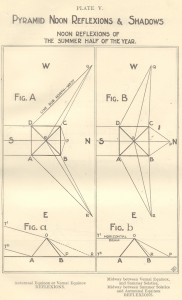 The Ark and Deliverance
The Ark and Deliverance
But there is more. Remember how the Bible describes the flood as occurring on the 17th day of the second month of the pre-flood calendar, a day which modern tradition observes in ignorance as Halloween. Have you ever thought about the day Noah’s ark finally rested on the mountains of Ararat? Well, that day was just as symbolically important? Here take a look:
And the waters returned from off the earth continually: and after the end of the hundred and fifty days the waters were abated. And the ark rested in the seventh month, on the seventeenth day of the month, upon the mountains of Ararat. (Genesis 8:3-4)
Yes indeed, the ark rested on a date which YHWH, hundreds of years later, would commemorate as Feast of Unleavened Bread. So in wonderful prophetic symbolism Noah and his family were delivered from the flood on the 17th day of the 7th month which according to Israel’s religious calendar after the exodus became the 17th day of the1st month. In modern calendar terms this would be our March or April. In other words, the ark rested on the mountains of Ararat on the same day in which Israel was delivered from Egyptian bondage. Then over a millennium later on that very same day, Yeshua the promised Messiah, rose from the grave and became the firstfruits of them that slept, thus delivering mankind from their bondage to sin.
But now is Christ risen from the dead, and become the firstfruits of them that slept. For since by man came death, by man came also the resurrection of the dead. For as in Adam all die, even so in Christ shall all be made alive. But every man in his own order: Christ the firstfruits; afterward they that are Christ’s at his coming. (1 Corinthians 15:20-23)
You see, the Israel that lived in the shadows and reflections of the Great Pyramid was only reminded of the judgment of God. The Israel that left Egypt was given the promise of a coming redeemer. How’s that for a new perspective on the Flood and the Exodus!
The Flood and Daniel 9
The above context provides a rather unique perspective on Israel’s calendar system and the promised Redeemer but there is another aspect to the flood story and the Messiah. In Daniel 9 we have the most important messianic prophecy in the Bible. Commonly called the Prophecy of 70 Weeks, its importance lies in the fact that it is the only prophecy in the entire Bible which gives a specific and datable timeline for the coming of the Messiah.
Daniel 9:25 tells us that after 7 “weeks” the Messiah will come. Keep in mind that the term weeks in Daniel 9 comes from the Hebrew Shabuwa and simply means sevens. The period of time intended by the prophecy is never stated.
Know therefore and understand, that from the going forth of the commandment to restore and to build Jerusalem unto the Messiah the Prince shall be seven weeks [sevens],… (Daniel 9:25a)
I won’t go into all the details in this article, but in Daniel 9:26 the prophecy goes on to tell us that the Messiah will be “cut off”. We know in retrospect from both the Old and New Testaments that the Messiah would have a dual role in the affairs of mankind. He would be both a suffering servant as described in Isaiah 53 and a future king as described in Luke 1:31-33. Here in Daniel 9:26 though we have a description of the Messiah as a suffering servant.
And after threescore and two weeks shall Messiah be cut off, but not for himself: (Daniel 9:26a)
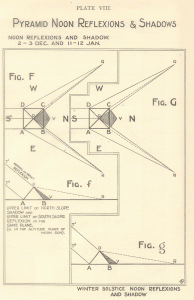 Notice in the passage above, it says that the Messiah will be “cut off, but not for himself”. This is where we find an amazing connection between the promised Messiah and the flood of Noah’s day. You see the term “cut off” in Daniel 9:26 comes from the Hebrew karath which means to cut off or cut down. As many scholars have noted over the years, the first occurrence of a Hebrew word in the Bible often provides additional insights into its meaning. Here in Daniel 9:26 we find such an example because the first occurrence of the work karath comes to us from the flood story.
Notice in the passage above, it says that the Messiah will be “cut off, but not for himself”. This is where we find an amazing connection between the promised Messiah and the flood of Noah’s day. You see the term “cut off” in Daniel 9:26 comes from the Hebrew karath which means to cut off or cut down. As many scholars have noted over the years, the first occurrence of a Hebrew word in the Bible often provides additional insights into its meaning. Here in Daniel 9:26 we find such an example because the first occurrence of the work karath comes to us from the flood story.
And I will establish my covenant with you; neither shall all flesh be cut off [karath] any more by the waters of a flood; neither shall there any more be a flood to destroy the earth. (Genesis 9:11)
Take a moment to read Daniel 9:26a once again. Notice it says the Messiah will be karath “but not for himself”. Contrast that with Noah’s day were we are told that nearly all mankind was cut off (karath) because of their sins. In Noah’s day mankind paid the required price for their sins. Daniel prophesied that a day would come when the Messiah would pay that price (karath) in place of mankind, it was his blood which would atoned for the sins of humanity.
Not for Himself indeed!
Let me give you a few examples from the Biblical record illustrating how the Messiah was cut off for the sins of mankind:
Surely he hath borne our griefs, and carried our sorrows: yet we did esteem him stricken, smitten of God, and afflicted. But he was wounded for our transgressions, he was bruised for our iniquities: the chastisement of our peace was upon him; and with his stripes we are healed. (Isaiah 53:4-5)
And one shall say unto him, What are these wounds in thine hands? Then he shall answer, Those with which I was wounded in the house of my friends. (Zechariah 13:6)
So Christ was once offered to bear the sins of many; and unto them that look for him shall he appear the second time without sin unto salvation. (Hebrews 9:28)
For Christ also hath once suffered for sins, the just for the unjust, that he might bring us to God, being put to death in the flesh, but quickened by the Spirit: By which also he went and preached unto the spirits in prison; Which sometime were disobedient, when once the longsuffering of God waited in the days of Noah, while the ark was a preparing, wherein few, that is, eight souls were saved by water. The like figure whereunto even baptism doth also now save us (not the putting away of the filth of the flesh, but the answer of a good conscience toward God,) by the resurrection of Jesus Christ: Who is gone into heaven, and is on the right hand of God; angels and authorities and powers being made subject unto him. (1 Peter 3:18-22)
Did you catch the analogy Peter made above? The same waters which “baptized” the world and removed sin also lifted the ark and brought deliverance from the death. In a like manner it was Yeshua’s resurrection which brings salvation and deliverance from sin.
And the waters prevailed, and were increased greatly upon the earth; and the ark went upon the face of the waters. (Genesis 7:18)
Therefore we are buried with him by baptism into death: that like as Christ was raised up from the dead by the glory of the Father, even so we also should walk in newness of life. (Romans 6:4)
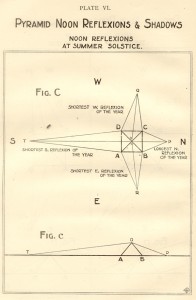 The Flood and the Messiah
The Flood and the Messiah
So next time you’re thinking about Israel and their exodus from Egypt remember the last surviving wonder of the ancient world. Remember a monument which Strabo described as, “…a building let down from heaven without the aid of human hands.” A megalithic wonder which reminded all Egypt of YHWH’s judgment on a sinful world. A monument which in its own way points mankind to the promise of a coming redeemer.
In that day shall there be an altar to YHWH in the midst of the land of Egypt, and a pillar at the border thereof to YHWH. And it shall be for a sign and for a witness unto YHWH of hosts in the land of Egypt: for they shall cry unto YHWH because of the oppressors, and he shall send them a saviour, and a great one, and he shall deliver them. (Isaiah 19:19-20)
A Berean’s Challenge
For those Bereans out there who love to dig deeper into YHWH’s word, I have a challenge for you. In Daniel 9 there are three Hebrew words which the Bible first uses in describing the events of the flood. We already looked at the word karath which was used to describe mankind being “cut off” from the earth. The other two words are gabar (prevail) and beriyth (covenant). It was no accident that all three of these words found in Daniel 9 are first found in the flood story and the destruction of mankind. See if you can find the connection.
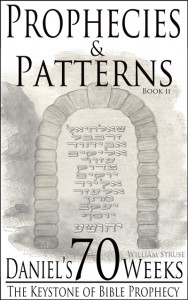 YHWH willing, in a couple of weeks I will be releasing Book II in my Prophecy and Patterns series, Daniel’s 70 Weeks: The Keystone of Bible Prophecy. In the book we’ll search for an answer to these intriguing questions and many others as well. Remember if you are a blog subscriber you’ll receive a complimentary digital copy of the book when it is released. In the meantime, I hope you enjoy your own Biblical treasure hunt for the wonders YHWH has hidden for us to find.
YHWH willing, in a couple of weeks I will be releasing Book II in my Prophecy and Patterns series, Daniel’s 70 Weeks: The Keystone of Bible Prophecy. In the book we’ll search for an answer to these intriguing questions and many others as well. Remember if you are a blog subscriber you’ll receive a complimentary digital copy of the book when it is released. In the meantime, I hope you enjoy your own Biblical treasure hunt for the wonders YHWH has hidden for us to find.
It is the glory of God to conceal a thing: but the honour of kings is to search out a matter. (Proverbs 25:2)
Authors note: All the charts in this article come from Davidson’s Pyramid Records (1924)

